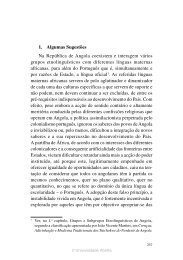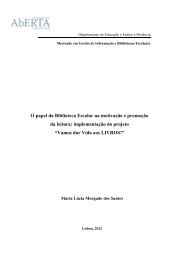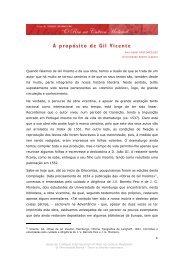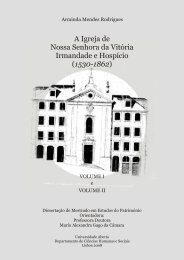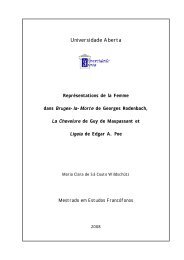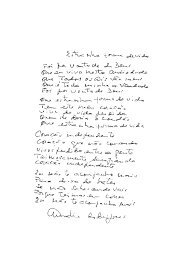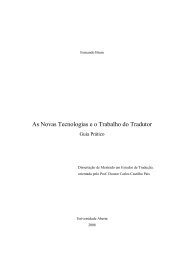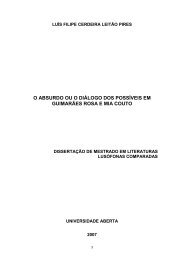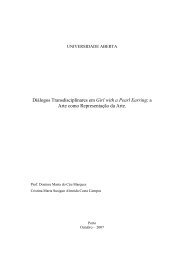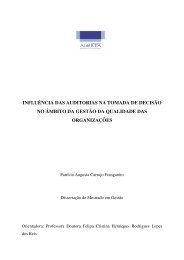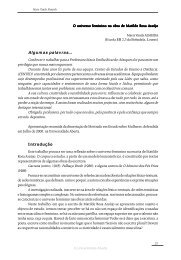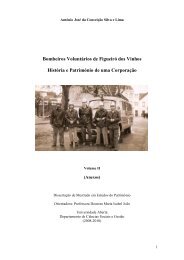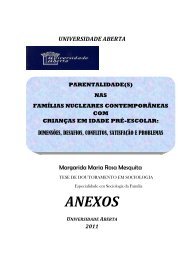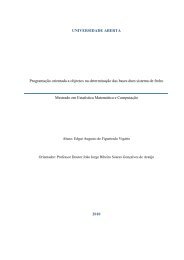- Page 1 and 2: Dina Isabel Francisco Alberto Santo
- Page 3 and 4: AGRADECIMENTOS Nesta caminhada, mui
- Page 5 and 6: 3.1.- Da família tradicional à fa
- Page 7 and 8: ANEXOS ANEXO I- Guião de entrevist
- Page 9 and 10: Quadro nº 18- Relacionamento entre
- Page 11 and 12: Gráfico nº 14 - Coabitava com o i
- Page 13 and 14: Gráfico nº 35- (Questão nº 3) O
- Page 15 and 16: Gráfico nº 54- Avaliação do Sco
- Page 17 and 18: ÍNDICE DE FOTOGRAFIAS Fotografia n
- Page 19: uma vez que é a mulher que continu
- Page 23 and 24: ___________________________________
- Page 25 and 26: ___________________________________
- Page 27 and 28: ___________________________________
- Page 29 and 30: ___________________________________
- Page 31 and 32: ___________________________________
- Page 33 and 34: ___________________________________
- Page 35 and 36: ___________________________________
- Page 37 and 38: ___________________________________
- Page 39 and 40: ___________________________________
- Page 41 and 42: ___________________________________
- Page 43 and 44: ___________________________________
- Page 45 and 46: ___________________________________
- Page 47 and 48: ___________________________________
- Page 49 and 50: ___________________________________
- Page 51 and 52: ___________________________________
- Page 53 and 54: ___________________________________
- Page 55 and 56: ___________________________________
- Page 57 and 58: ___________________________________
- Page 59 and 60: ___________________________________
- Page 61 and 62: ___________________________________
- Page 63 and 64: ___________________________________
- Page 65 and 66: ___________________________________
- Page 67 and 68: ___________________________________
- Page 69 and 70: ___________________________________
- Page 71 and 72:
___________________________________
- Page 73 and 74:
___________________________________
- Page 75 and 76:
___________________________________
- Page 77 and 78:
___________________________________
- Page 79 and 80:
___________________________________
- Page 81 and 82:
___________________________________
- Page 83 and 84:
___________________________________
- Page 85 and 86:
___________________________________
- Page 87 and 88:
___________________________________
- Page 89 and 90:
___________________________________
- Page 91 and 92:
___________________________________
- Page 93 and 94:
___________________________________
- Page 95 and 96:
___________________________________
- Page 97 and 98:
___________________________________
- Page 99 and 100:
___________________________________
- Page 101 and 102:
___________________________________
- Page 103 and 104:
___________________________________
- Page 105 and 106:
___________________________________
- Page 107 and 108:
___________________________________
- Page 109 and 110:
___________________________________
- Page 111 and 112:
___________________________________
- Page 113 and 114:
___________________________________
- Page 115 and 116:
___________________________________
- Page 117 and 118:
___________________________________
- Page 119 and 120:
___________________________________
- Page 121 and 122:
___________________________________
- Page 123 and 124:
___________________________________
- Page 125 and 126:
___________________________________
- Page 127 and 128:
___________________________________
- Page 129 and 130:
___________________________________
- Page 131 and 132:
___________________________________
- Page 133 and 134:
___________________________________
- Page 135 and 136:
___________________________________
- Page 137 and 138:
___________________________________
- Page 139 and 140:
___________________________________
- Page 141 and 142:
___________________________________
- Page 143 and 144:
___________________________________
- Page 145 and 146:
___________________________________
- Page 147 and 148:
___________________________________
- Page 149 and 150:
___________________________________
- Page 151 and 152:
___________________________________
- Page 153 and 154:
___________________________________
- Page 155 and 156:
___________________________________
- Page 157 and 158:
___________________________________
- Page 159 and 160:
___________________________________
- Page 161 and 162:
___________________________________
- Page 163 and 164:
___________________________________
- Page 165 and 166:
___________________________________
- Page 167 and 168:
___________________________________
- Page 169 and 170:
___________________________________
- Page 171 and 172:
___________________________________
- Page 173 and 174:
___________________________________
- Page 175 and 176:
___________________________________
- Page 177 and 178:
___________________________________
- Page 179 and 180:
___________________________________
- Page 181 and 182:
___________________________________
- Page 183 and 184:
___________________________________
- Page 185 and 186:
___________________________________
- Page 187 and 188:
___________________________________
- Page 189 and 190:
___________________________________
- Page 191 and 192:
___________________________________
- Page 193 and 194:
___________________________________
- Page 195 and 196:
___________________________________
- Page 197 and 198:
___________________________________
- Page 199 and 200:
___________________________________
- Page 201 and 202:
___________________________________
- Page 203 and 204:
___________________________________
- Page 205 and 206:
___________________________________
- Page 207 and 208:
___________________________________
- Page 209 and 210:
___________________________________
- Page 211 and 212:
___________________________________
- Page 213 and 214:
___________________________________
- Page 215 and 216:
___________________________________
- Page 217 and 218:
___________________________________
- Page 219 and 220:
___________________________________
- Page 221 and 222:
___________________________________
- Page 223 and 224:
___________________________________
- Page 225 and 226:
___________________________________
- Page 227 and 228:
___________________________________
- Page 229 and 230:
___________________________________
- Page 231 and 232:
___________________________________
- Page 233 and 234:
___________________________________
- Page 235 and 236:
___________________________________
- Page 237 and 238:
___________________________________
- Page 239 and 240:
___________________________________
- Page 241 and 242:
___________________________________
- Page 243 and 244:
___________________________________
- Page 245 and 246:
___________________________________
- Page 247 and 248:
___________________________________
- Page 249 and 250:
___________________________________
- Page 251 and 252:
___________________________________
- Page 253 and 254:
___________________________________
- Page 255 and 256:
___________________________________
- Page 257 and 258:
___________________________________
- Page 259 and 260:
___________________________________
- Page 261 and 262:
___________________________________
- Page 263 and 264:
___________________________________
- Page 265 and 266:
___________________________________
- Page 267 and 268:
___________________________________
- Page 269 and 270:
___________________________________
- Page 271 and 272:
___________________________________
- Page 273 and 274:
___________________________________
- Page 275 and 276:
___________________________________
- Page 277 and 278:
___________________________________
- Page 279 and 280:
___________________________________
- Page 281 and 282:
___________________________________
- Page 283 and 284:
___________________________________
- Page 285 and 286:
___________________________________
- Page 287 and 288:
___________________________________
- Page 289 and 290:
___________________________________
- Page 291 and 292:
___________________________________
- Page 293 and 294:
___________________________________
- Page 295 and 296:
___________________________________
- Page 297 and 298:
___________________________________
- Page 299 and 300:
___________________________________
- Page 301 and 302:
___________________________________
- Page 303 and 304:
1. Sexo: __________________________
- Page 305 and 306:
___________________________________
- Page 307 and 308:
___________________________________
- Page 309:
___________________________________



